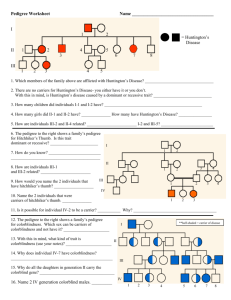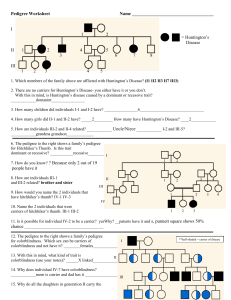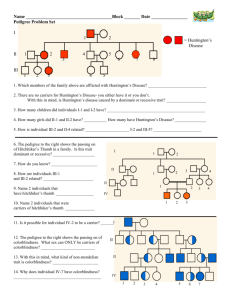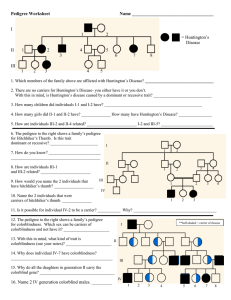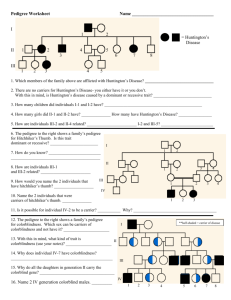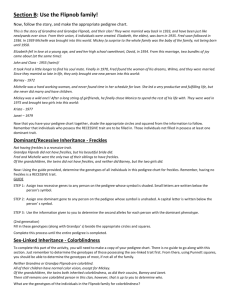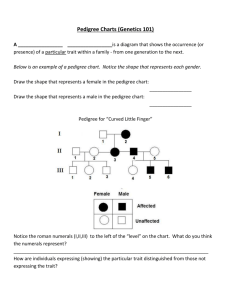Pedigree Worksheet: Genetics Practice
advertisement
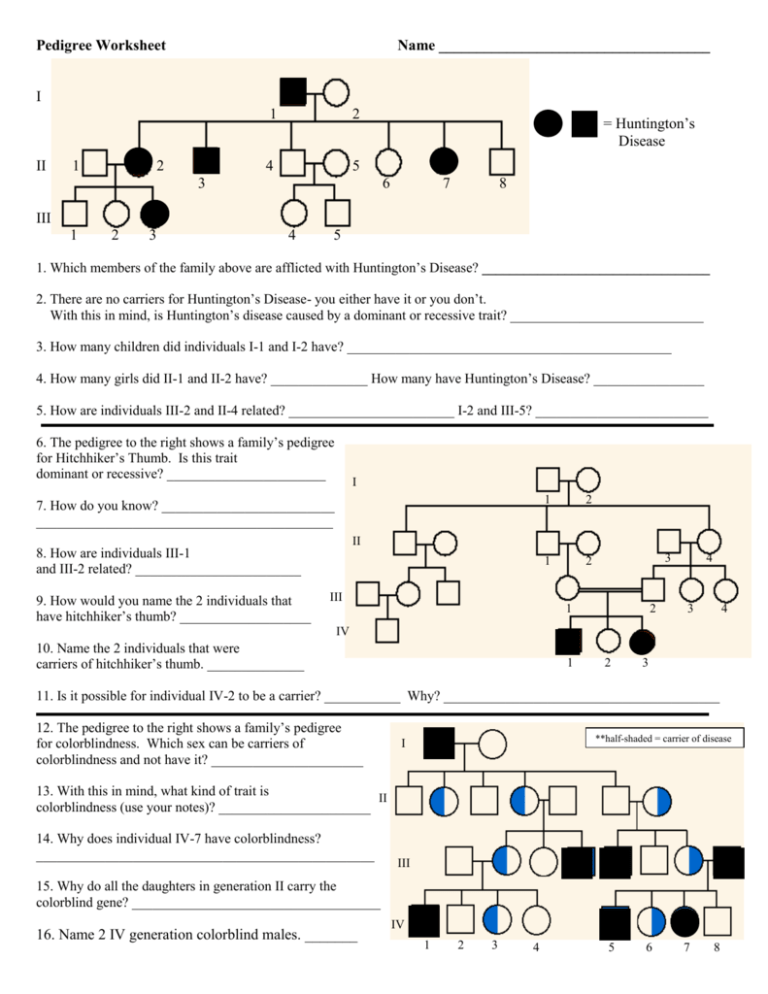
Pedigree Worksheet Name ____________________________________ I II 1 2 1 2 4 5 3 = Huntington’s Disease 6 7 8 III 1 2 3 4 5 1. Which members of the family above are afflicted with Huntington’s Disease? _________________________________ 2. There are no carriers for Huntington’s Disease- you either have it or you don’t. With this in mind, is Huntington’s disease caused by a dominant or recessive trait? ____________________________ 3. How many children did individuals I-1 and I-2 have? _______________________________________________ 4. How many girls did II-1 and II-2 have? ______________ How many have Huntington’s Disease? ________________ 5. How are individuals III-2 and II-4 related? ________________________ I-2 and III-5? _________________________ 6. The pedigree to the right shows a family’s pedigree for Hitchhiker’s Thumb. Is this trait dominant or recessive? _______________________ I 7. How do you know? _________________________ ___________________________________________ 1 2 1 2 II 8. How are individuals III-1 and III-2 related? ________________________ 9. How would you name the 2 individuals that have hitchhiker’s thumb? ___________________ III 3 1 2 4 3 4 IV 10. Name the 2 individuals that were carriers of hitchhiker’s thumb. ______________ 1 2 3 11. Is it possible for individual IV-2 to be a carrier? ___________ Why? ________________________________________ 12. The pedigree to the right shows a family’s pedigree for colorblindness. Which sex can be carriers of colorblindness and not have it? ______________________ **half-shaded = carrier of disease I 13. With this in mind, what kind of trait is II colorblindness (use your notes)? ______________________ 14. Why does individual IV-7 have colorblindness? _________________________________________________ III 15. Why do all the daughters in generation II carry the colorblind gene? ____________________________________ IV 16. Name 2 IV generation colorblind males. _______ame ____________________________________ 1 2 3 4 5 6 7 8 KEY than one possibiliPedigree Worksheet I II 1 2 1 2 4 5 3 = Huntington’s Disease 6 7 8 III 1 2 3 4 5 1. Which members of the family above are afflicted with Huntington’s Disease? I1, II2, II3, II7, III3 2. There are no carriers for Huntington’s Disease- you either have it or you don’t. With this in mind, is Huntington’s disease caused by a dominant or recessive trait? Dominant 3. How many children did individuals I-1 and I-2 have? 6 4. How many girls did II-1 and II-2 have? 2 How many have Huntington’s Disease? 1 or 5 5. How are individuals III-2 and II-4 related? Uncle/Niece I-2 and III-5? Grandma/Grandson 6. The pedigree to the right shows a family’s pedigree for Hitchhiker’s Thumb. Is this trait dominant or recessive? Recessive I 7. How do you know? III1 and III2 do not have it but their children do. 1 2 1 2 II 8. How are individuals III-1 and III-2 related? Cousins/Marriage 9. How would you name the 2 individuals that have hitchhiker’s thumb? IV1 and IV3 III 3 1 2 4 3 4 IV 10. Name the 2 individuals that were carriers of hitchhiker’s thumb. III1 and III2 1 2 3 11. Is it possible for individual IV-2 to be a carrier? Yes Why? b/c parents were heterozygous 12. The pedigree to the right shows a family’s pedigree for colorblindness. Which sex can be carriers of colorblindness and not have it? Females 13. With this in mind, what kind of trait is colorblindness (use your notes)? Sexlinked/recessive **half-shaded = carrier of disease I II 14. Why does individual IV-7 have colorblindness? b/c mom was a carrier and dad was affected III 15. Why do all the daughters in generation II carry the colorblind gene? b/c dad was affected and its on the X 16. Name 2 IV generation colorblind males. IV1, IV5 IV 1 2 3 4 5 6 7 8 Pedigree Worksheet KEY Genetics Pedigree Worksheet A pedigree is a chart of a person’s ancestors that is used to analyze genetic inheritance of certain traits – especially diseases. The symbols used for a pedigree are: 1. Is this trait dominant or recessive? Explain your answer. It is a recessive trait because generation II does not have the disease and Generations I and II do have it. 2. How can you know for sure that individuals II-3 and II-4 are heterozygous? Because their offspring have the disease so they are both carriers of it. 3. Brown eyes are a dominant eye-color allele and blue eyes are recessive. A brown-eyed woman whose father had blue eyes and whose mother had brown eyes marries a brown-eyed man whose parents are also browneyed. They have a son who is blue-eyed. Please draw a pedigree showing all four grandparents, the two parents, and the son. Indicate which individuals you are certain of their genotype and where there are more than one possibilities.
